
Here’s an opening line from the pun-filled instruction manual:
“Your PET ROCK will be a devoted friend and companion for many years to come,” stated Dahl’s booklet, which featured illustrations of the rocks in inaction. “Rocks enjoy a rather long life span so the two of you will never have to part — at least not on your PET ROCK’s account. Once you have transcended the awkward training stage your rock will mature into a faithful, obedient, loving pet with but one purpose in life — to be at your side when you want it to, and to go lie down when you don’t.”

The other 32 pages are equally tongue-in-cheek.
“Your PET ROCK will be a devoted friend and companion for many years to come,” states the manual, which features diagrams of your rock in action. “Rocks enjoy a rather long life span so the two of you will never have to part — at least not on your PET ROCK’s account. Once you have transcended the awkward training stage your rock will mature into a faithful, obedient, loving pet with but one purpose in life — to be at your side when you want it to, and to go lie down when you don’t.” So you went to the store to purchase a gray stone packaged in a cardboard box with breathing holes cut-out, and straw. It even came with a booklet with gags, and play on words that referred to these inanimate rocks as actual pets. Pet Rock could even learn to sit, stay, and rollover (thought the last one required some help from the trainer).

For six months in 1975 Pet Rock was one of the biggest fads in America, eventually selling over 1.5 million units, making creator Gary Dahl a millionaire virtually overnight. Though the product made Dahl wealthy, it also made him wary, for he was sought after for quite a while by hordes of would-be inventors, seeking his input on their next big product. “There’s a bizarre lunatic fringe who feel I owe them a living,” Mr. Dahl told The Associated Press in 1988. “Sometimes I look back and wonder if my life wouldn’t have been simpler if I hadn’t done it.”
